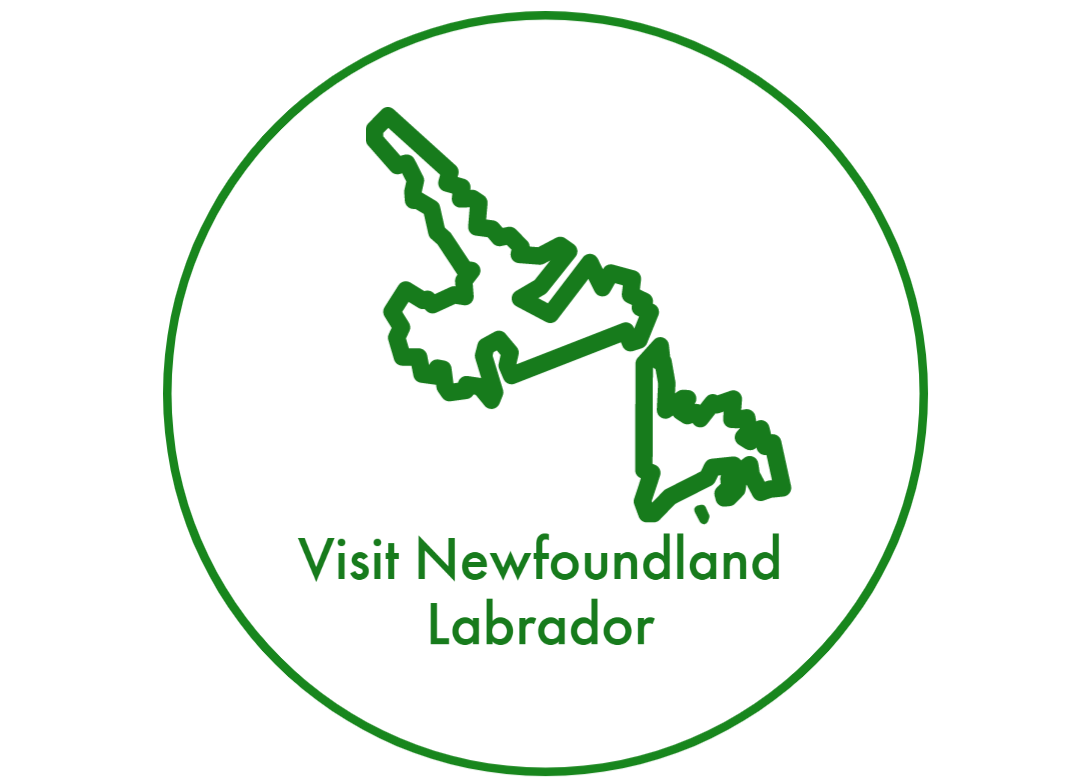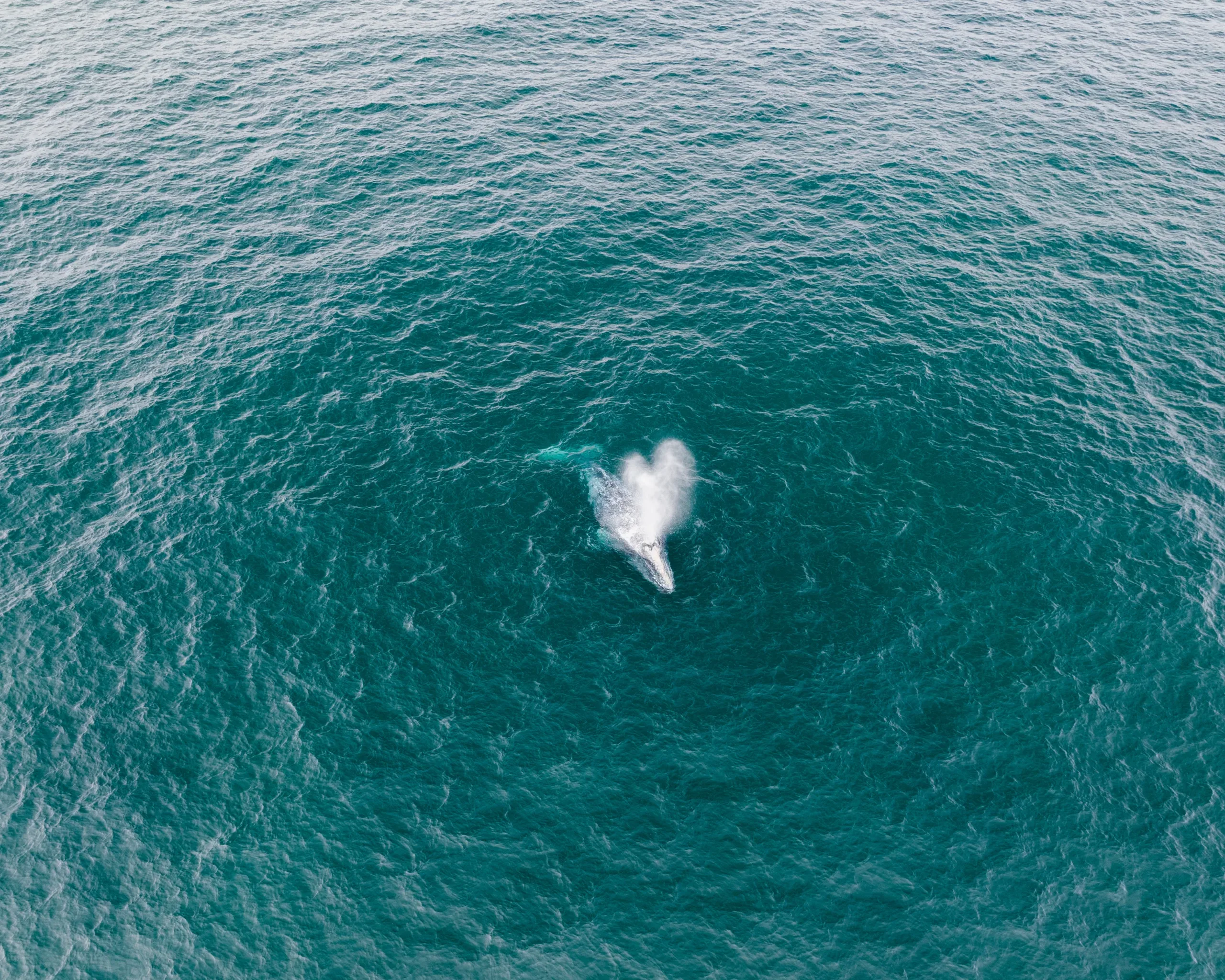Discover The Magnificent World Of Newfoundland Whale Watching
Come discover the magnificent world of Newfoundland Whale Watching. The best time to go whale watching in Newfoundland is during the summer months when whale populations are at their peak. During this time, you have a higher chance of spotting various whale species, such as humpback, minke, and orcas. These majestic creatures migrate to Newfoundland coastal waters to feed and mate, creating fantastic opportunities for whale watching enthusiasts.
The warmer weather and calmer seas also make for a more enjoyable experience. So, if you’re planning a whale watching trip to Newfoundland, schedule it between June and September for the best chances of witnessing these incredible marine mammals.
Newfoundland offers excellent whale watching spots along its rugged coastline. Witless Bay Reserve is one of the top locations to watch whales, just a short drive from St. John’s. This reserve is home to thousands of Atlantic puffins and serves as a feeding ground for various whale species. Another popular spot is Trinity Bay, where you can spot humpback whales breaching and slapping their tails on the water’s surface. Other notable areas include Bonavista, Twillingate, and St. Anthony. These locations provide breathtaking scenery and opportunities to observe whales in their natural habitat, making your whale watching experience in Newfoundland truly unforgettable.
Cost of Whale Watching
The cost of whale watching in Newfoundland varies depending on several factors, such as the tour operator, tour duration, and additional services offered. On average, a whale watching tour in Newfoundland can range from $60 to $150 per person. However, keep in mind that prices may fluctuate, and it’s always a good idea to check with different tour operators for the most up-to-date information.
When considering the cost, it’s important to remember that whale watching tours in Newfoundland typically provide more than just a chance to see whales. Many operators share valuable insights about the whales and their behaviour, enhancing your overall experience.
While the cost of whale watching tours in Newfoundland may vary, choosing a reputable operator who prioritizes the safety and well-being of the whales is essential. Look for companies committed to responsible wildlife viewing practices and environmental conservation. By selecting a tour that aligns with your values, you can ensure a memorable and ethical whale watching experience in the pristine waters of Newfoundland.
More Newfoundland and Labrador Travel Guides
- A Guide to Experiencing the Thrills of Newfoundland Whale Watching Season
- How To Best Experience Newfoundland Whale Watching Season
- How to Discover Icebergs in Newfoundland
- Where Big icebergs off the coast of Newfoundland come from
- How To Experience 500,000 Colorful Puffins in Newfoundland
- How To See both Whales and Puffins in Newfoundland
- How to Best Enjoy Whale Watching in Newfoundland and Labrador
Whale Species
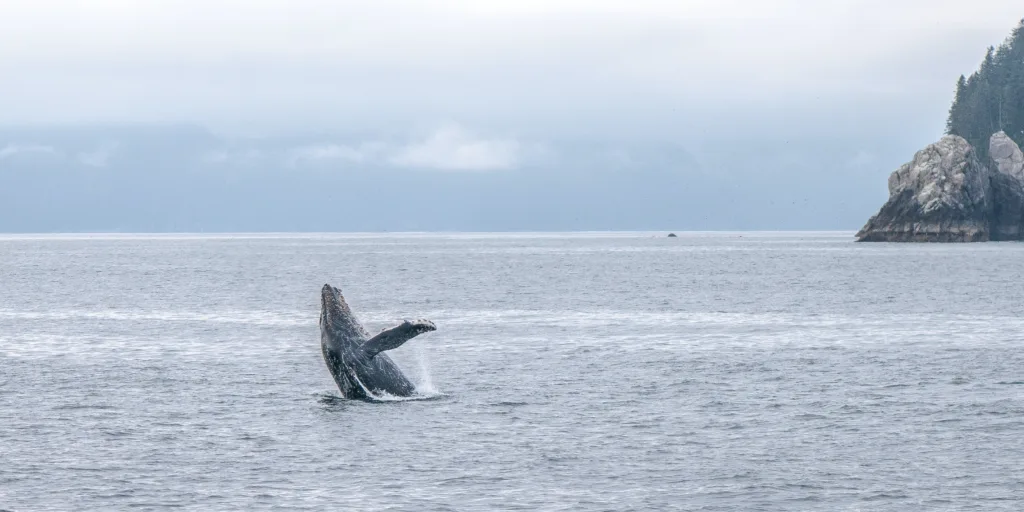
Newfoundland is home to a diverse range of whale species, making it an ideal destination for whale watching enthusiasts. Some of the most common whale species found in the waters of Newfoundland include humpback whales, minke whales, fin whales, and orcas (also known as killer whales). Humpback whales are particularly famous for their acrobatic displays, such as breaching and tail slapping, which make for incredible photo opportunities. On the other hand, Minke whales are smaller and known for their curious nature, often approaching boats to get a closer look. Fin whales, the second-largest whale species, can also be spotted in Newfoundland and are known for their impressive size and streamlined bodies. Lastly, orcas are apex predators occasionally seen in Newfoundland waters.
How close can you get to Whale?
The proximity to whales during a whale watching tour in Newfoundland depends on various factors, including the behaviour of the whales, weather conditions, and the regulations in place to protect the animals. While every effort is made to approach whales respectfully, it’s important to remember that these are wild animals, and their comfort and safety take precedence. Whale watching operators in Newfoundland follow guidelines that dictate a minimum safe distance between boats and whales. However, whales are known to exhibit curiosity and may approach boats on their own accord, allowing for incredible close encounters. It’s important to remember that the welfare of the whales is paramount, and responsible operators prioritize the well-being of these magnificent creatures.
Other Marine Wildlife While Whale Watching
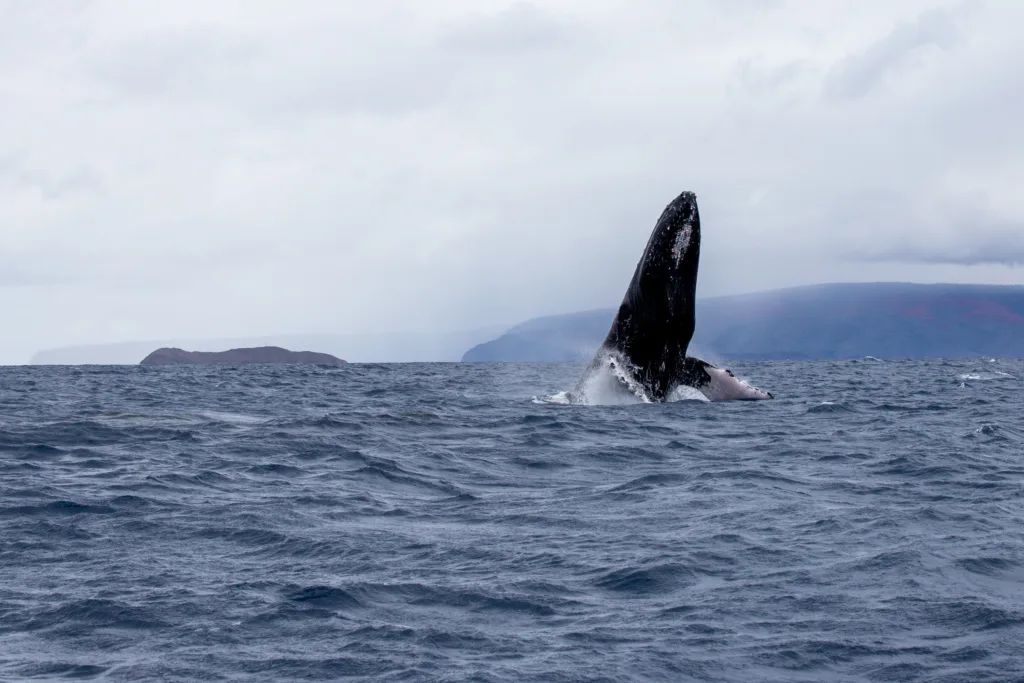
While whale watching in Newfoundland, it’s not uncommon to encounter other fascinating marine wildlife. The waters surrounding Newfoundland are teeming with diverse marine ecosystems, providing a habitat for various species. Alongside whales, you may spot dolphins, porpoises, seals, and a wide array of seabirds, including puffins, gannets, and bald eagles. Dolphins enjoy riding the bow waves created by boats, showcasing their playful nature. Seals can be seen lounging on rocks or bobbing in the water while seabirds soar overhead or dive into the sea searching for food. The presence of these marine animals adds an extra layer of excitement and wonder to your whale watching experience in Newfoundland.
Whale Watching restrictions and regulations
Specific restrictions and regulations are in place to ensure responsible whale watching practices in Newfoundland. These regulations are designed to protect the well-being of the whales and their habitats, as well as to maintain the sustainability of the industry. Operators must adhere to guidelines that govern the minimum distance from the whales, the number of boats allowed near a whale, and the duration spent observing the animals. These guidelines are essential for minimizing disturbance and stress to the whales, allowing them to engage in natural behaviours without interference.
Duration of Whale Watching Tour
The duration of a typical whale watching tour in Newfoundland can vary depending on the operator and the specific tour package you choose. On average, whale watching tours in Newfoundland range from 2 to 4 hours. This timeframe allows ample opportunity to explore the coastal waters and increases your chances of encountering whales and other marine wildlife. More extended tours may be available for those seeking a more immersive experience or for specific wildlife photography excursions. It’s important to check with the tour operator regarding the duration of the tour you are interested in and to plan accordingly. Remember that weather conditions and wildlife behaviour can also impact the duration of the tour, as operators prioritize the safety and the welfare of both passengers and the whales.
Places to Stay
Newfoundland offers a range of accommodations near whale watching sites, ensuring a convenient and comfortable stay during your visit. Depending on the region you plan to explore, you can find various options such as hotels, bed and breakfasts, cabins, and vacation rentals. For example, in St. John’s, the capital city of Newfoundland, there are numerous hotels and guesthouses to choose from. If you prefer a more remote location, coastal towns like Twillingate, Bonavista, or Trinity Bay offer charming accommodations with easy access to whale watching spots. It’s recommended to book your accommodation in advance, especially during the peak whale watching season, to secure the best options that suit your preferences and budget.
Ways to Whale Watch
When it comes to whale watching in Newfoundland, you can enjoy kayak, boat- and land-based experiences, each offering a unique perspective. Boat-based whale watching tours allow you to venture out into the open waters, providing a closer encounter with the whales. These tours typically involve a knowledgeable guide who shares insights and navigates the boat to prime whale watching areas. On the other hand, land-based whale watching allows you to observe whales from designated lookout points along the coast. These vantage points offer panoramic ocean views, and you can spot whales from the shore. Whether you choose a boat-based or land-based experience, both options provide exceptional opportunities to witness these magnificent creatures in their natural habitat.
The Double Whale and Icebergs
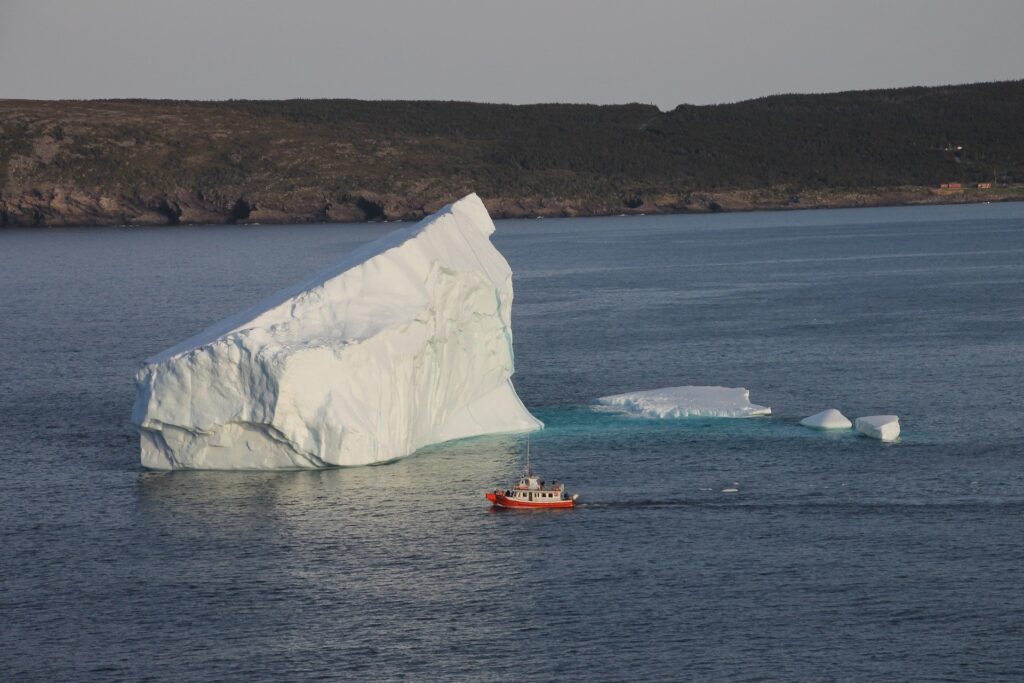
Icebergs in Newfoundland can be seen while whale watching, particularly during the spring and early summer. -Iceberg Alley is a prime destination for iceberg sightings. Icebergs are massive chunks of freshwater ice that break off from glaciers. They often make their way down the Labrador coast, passing by Newfoundland coastline. These breathtaking natural wonders create a stunning backdrop for whale watching excursions, adding an extra element of beauty to your experience. The combination of witnessing both whales and icebergs in Newfoundland pristine waters is truly a remarkable sight to behold.
The Weather While Whale Watching
Weather conditions play a crucial role in whale watching experiences in Newfoundland. Coastal waters can be unpredictable, so it’s important to consider the weather forecast before planning your trip. Ideally, you’ll choose a day with calm seas and clear skies for optimal visibility. Windy or foggy conditions can make spotting whales and appreciating their behaviours more challenging. Additionally, rough seas can impact the comfort and safety of boat-based tours. It’s always advisable to check with the tour operator regarding their policy in case of inclement weather. Remember, while weather conditions can be a factor, whale watching in Newfoundland can still be a rewarding and memorable experience.
Children can Participate in Whale Watching Tours.
Yes, children can participate in whale watching tours in Newfoundland, making it a fantastic family-friendly activity. Watching these majestic whales in their natural habitat can be a captivating and educational experience for children of all ages. Many whale watching operators in Newfoundland provide family-oriented tours that cater to the needs and interests of children. These tours often include informative commentary geared towards young learners, highlighting fascinating facts about whales and other marine wildlife. Check with the tour operator about any age restrictions or specific considerations for children, such as life jacket requirements. Additionally, it’s important to prepare children for the boat ride by ensuring they have dressed appropriately for the weather and taken necessary precautions, such as motion sickness medication if needed. With proper preparation and guidance, whale watching tours in Newfoundland can create lasting memories for the entire family and foster a deep appreciation for the natural world.
Whale Watching Dress Code
What should I wear when going whale watching? When going on a whale watching tour in Newfoundland, it’s essential to dress appropriately for the weather conditions and the possibility of ocean spray. Layering your clothing is recommended, allowing you to adjust your attire based on temperature changes throughout the tour. Start with a base layer fabric to keep you dry and comfortable. Over that, wear a warm, insulating layer such as a sweater. For the outermost layer, choose a waterproof and windproof jacket or a shell to protect you from ocean spray and potential rain. Remember to wear comfortable pants or leggings and sturdy footwear with good traction to ensure stability on the boat. Bringing a good hat and sunscreen to protect yourself from the sun is also a good idea. You can fully enjoy your whale watching experience in Newfoundland by dressing appropriately.
Whale Watching Educational Program
Yes, educational programs and researchers are actively involved in whale watching in Newfoundland. These programs aim to enhance the understanding of whale behaviour, migration patterns, and their ecological significance. Some whale watching tour operators collaborate with local marine research organizations or universities to collect data and contribute to ongoing research efforts. Some operators may have onboard guides who provide educational commentary about the whales and their conservation. By supporting these initiatives, your whale watching experience in Newfoundland becomes educational and contributes to the conservation and protection of these magnificent creatures.
Spotting Whales
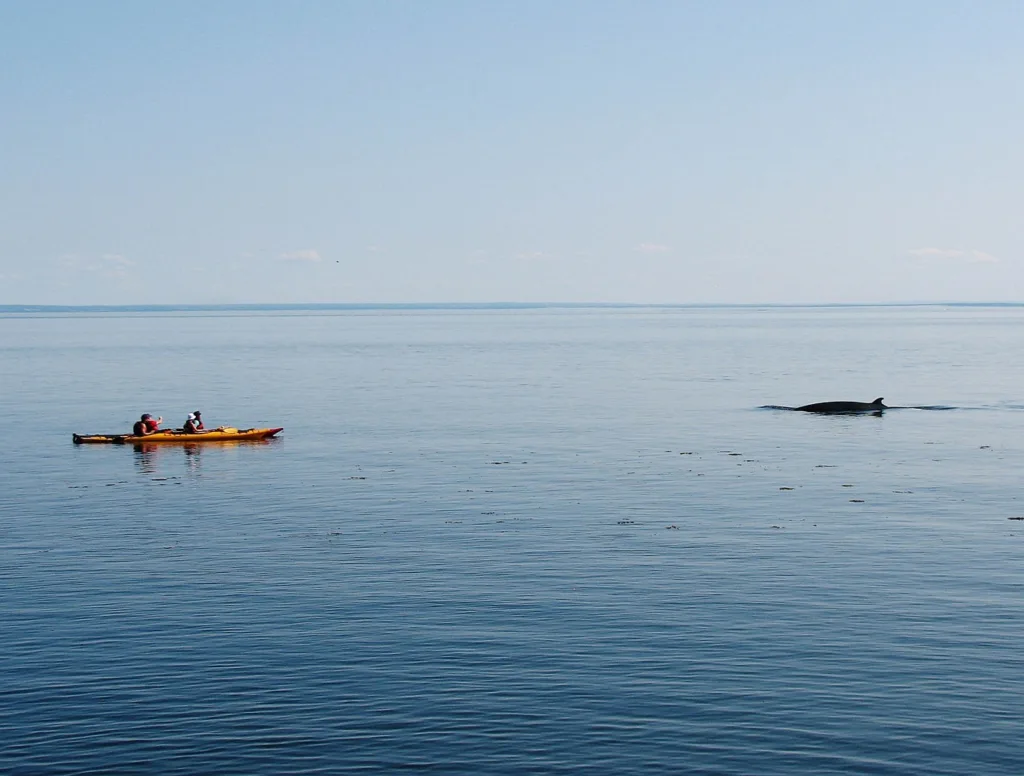
The success rate of spotting whales during a tour in Newfoundland can vary depending on several factors, including the time of year, weather conditions, and the tour operator’s expertise. However, Newfoundland coastal waters are known for their abundant whales, and the chances of seeing these majestic creatures are generally high. During the peak whale watching season, from June to September, the probability of spotting whales increases significantly. However, it’s important to note that wildlife sightings are not guaranteed as whales are wild animals, and their behaviours can be unpredictable. Nevertheless, reputable tour operators in Newfoundland have experienced guides and crews skilled at locating and tracking whales, maximizing your chances of a successful and rewarding whale watching experience.
While it is possible to go whale watching in Newfoundland without a tour guide, it is generally recommended to book a guided tour for the best experience. Whale watching tours offer numerous advantages, including the expertise of knowledgeable guides who can navigate to prime whale watching areas and provide valuable insights about the whales and their behaviours. They are familiar with the local marine ecosystem and know where and when to look for whales, significantly increasing your chances of sightings. Additionally, tour operators have specialized boats designed for optimal whale watching, providing better visibility and comfort. Joining a guided tour also ensures that you adhere to responsible whale watching practices and support conservation efforts. However, if you choose to go whale watching independently, it’s important to research and follow guidelines to minimize disturbance to the whales and ensure your safety.
The best time to Whale Watching is June to September.
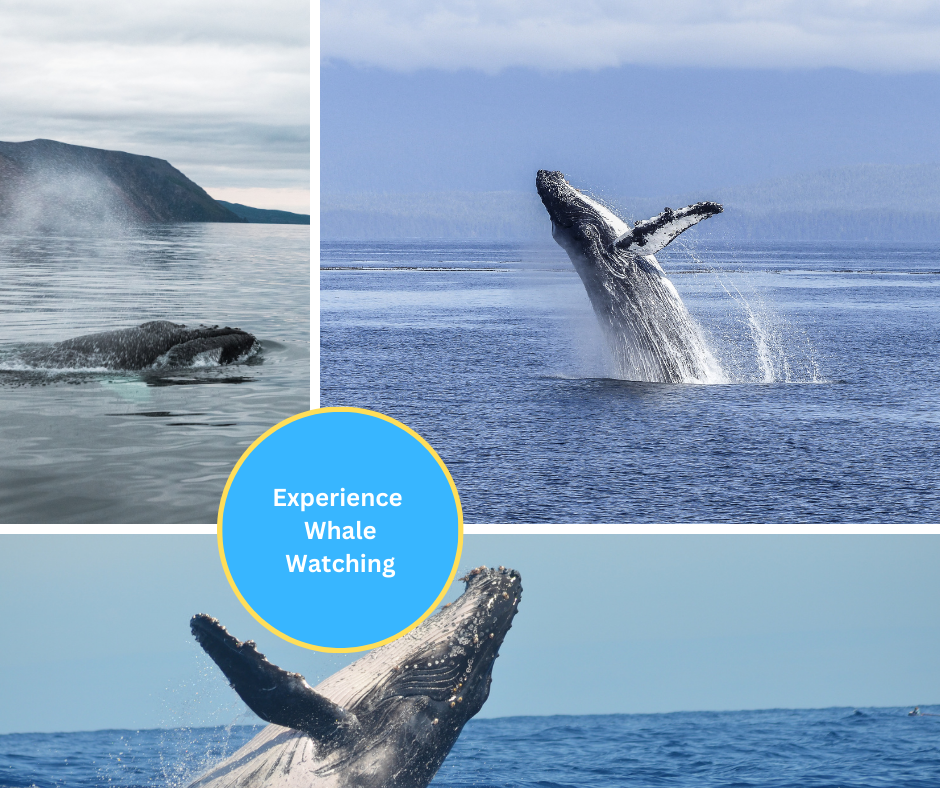
The best time to go whale watching in Newfoundland is during the peak season, which typically runs from June to September. During this period, whales are abundant in Newfoundland coastal waters as they migrate to feed on the rich marine resources. Humpback whales are particularly prevalent during this time, known for their impressive acrobatics and spectacular displays. The warmer weather and calmer summer seas also make it an ideal time for whale watching excursions. However, it’s important to note that whale sightings can vary, and factors such as weather conditions and the availability of food sources can influence their presence. It’s advisable to check with local tour operators for the most up-to-date information and to book your whale watching tour in advance to secure your spot during the peak season.
Whale Watching in Bonavista
The Bonavista Peninsula is renowned for its excellent whale watching opportunities. The waters off the Bonavista Peninsula are rich in marine life, attracting various whale species. Humpback whales are commonly sighted in this area, showcasing their breaching and tail-slapping behaviours. Minke and fin whales are also frequently spotted, adding to the diversity of sightings. The charming town of Trinity, located on the Bonavista Peninsula, is a popular starting point for whale watching tours. Its proximity to prime whale habitats and the presence of knowledgeable guides make it an ideal destination for an unforgettable whale watching experience. Exploring the Bonavista Peninsula offers the chance to witness whales and immerse yourself in Newfoundland breathtaking coastal landscapes.
Whale Watching at Witless Bay Ecological Reserve
The Witless Bay Ecological Reserve near St. John’s, Newfoundland, is exceptional for whale watching. The reserve is home to North America largest Atlantic puffin colony and serves as a feeding ground for various whale species. Humpback whales are frequently seen in these waters, showcasing their acrobatic displays. The presence of minke whales, fin whales, and even orcas further adds to the excitement of whale watching in this area. The Witless Bay Ecological Reserve offers guided boat tours that provide an up-close and personal experience with these magnificent creatures. The combination of witnessing whales, puffins, and other seabirds in their natural habitat makes the Witless Bay Ecological Reserve a must-visit destination for nature enthusiasts and whale lovers.
Whale Watching in Twillingate
The small coastal town of Twillingate in Newfoundland is another popular spot for whale watching. Situated along the island’s northeastern coast, Twillingate offers views of the Atlantic Ocean and is known as the “Iceberg Capital of the World.” While whale sightings are common in this area, it is also an excellent place to witness majestic icebergs floating by. The convergence of whales and icebergs creates a unique and inspiring experience for visitors. Humpback, minke, and fin whales are frequently spotted, along with seals and seabirds. Joining a whale watching tour in Twillingate allows you to witness the incredible beauty of whales and icebergs, making it a remarkable and memorable destination for nature enthusiasts.
Photographing of Whales during your Tour
When capturing stunning photographs of whales during your whale watching tour in Newfoundland, there are a few tips to keep in mind:
- Make sure you have a camera with a telephoto lens to zoom in and capture the details of the whales. A lens with a focal length of at least 200mm or longer is recommended for capturing close-up shots.
- Consider using a fast shutter speed to freeze the motion of the whales, especially during their energetic behaviours like breaching or tail slapping. It’s also important to anticipate the whale’s movements and be ready to capture the moment, as they can surface unpredictably. Pay attention to the composition of your photos, framing the whales against the scenic backdrop of the coastline or capturing the interaction between the whales and other wildlife.
- Be patient and observant. Whale watching is a dynamic experience, and you never know when an incredible photo opportunity will present itself.
Remember to enjoy the moment and respect the whales’ natural environment while capturing stunning photographs to treasure for a lifetime.
One of Newfoundland best places to see humpback whales is in the coastal waters around St. Vincent’s Beach in St. Vincent’s, Newfoundland. St. Vincent’s is located on the Irish Loop coast and is renowned for its extraordinary whale and bird population that visit each season. The water around St. Vincent’s, Newfoundland, is a rich feeding ground for these magnificent creatures. Humpback whales are attracted to the abundant food sources in the bay, making it a hotspot for sightings.
Unique Iceberg and Whale Sighting
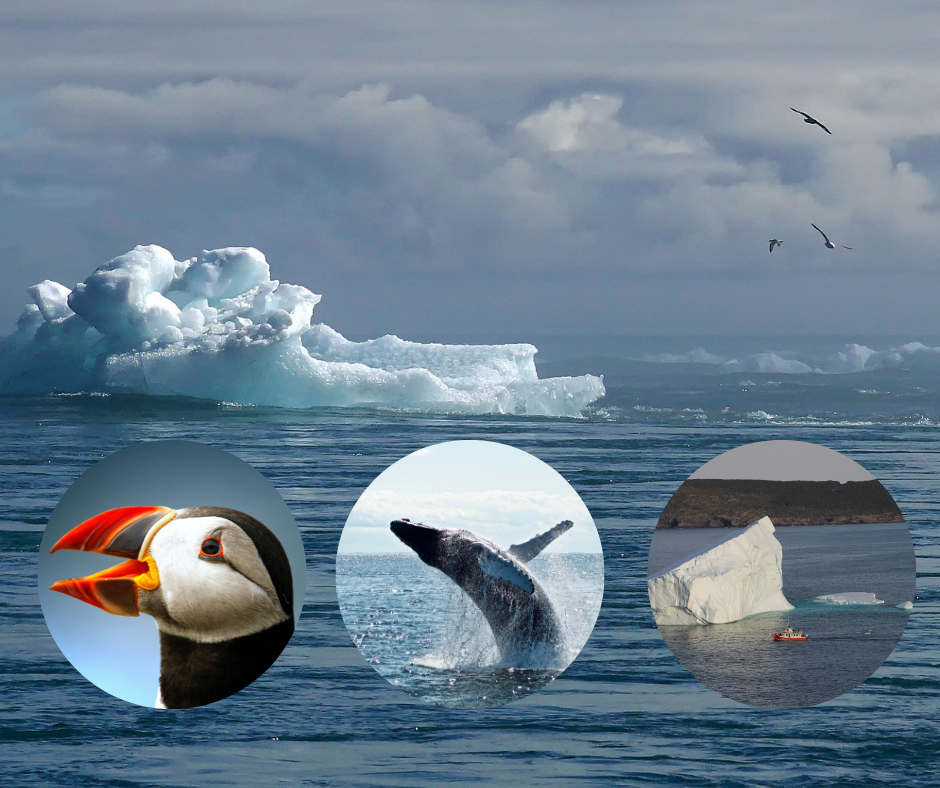
The top places to see icebergs and Whales are Fogo Island, Change Islands, Battle Harbour, Red Bay, and Point Amour. Combining iceberg watching with whale watching in Newfoundland is possible, providing a genuinely spectacular nature experience. Icebergs are common along Newfoundland coastline, especially during the spring and early summer. The presence of icebergs adds a sense of wonder and beauty to your whale watching excursion. While the primary focus may be on spotting whales, the chance to see these massive ice formations drifting through the ocean creates a unique and breathtaking backdrop. Witnessing the synergy between the gentle giants of the sea and the floating ice sculptures is an unforgettable experience showcasing Newfoundland natural wonders. Be sure to check with tour operators for specific iceberg sightings and safety considerations during your chosen time of visit.
Newfoundland diverse coastal regions offer a range of whale watching opportunities, allowing you to choose a location that suits your preferences and travel plans. The Avalon coast of Newfoundland, including areas such as St. John’s, and Witless Bay, is known for its rich marine biodiversity and proximity to prime whale habitats. This region provides excellent whale watching experiences, with humpback whales being the most commonly spotted species. Newfoundland Eastern and Central regions, particularly the Bonavista Peninsula and Twillingate, also offers exceptional whale watching opportunities. These regions are famous for their scenic coastal landscapes and are frequented by humpback, minke, and fin whales. Whether you choose the Eastern or Avalon coasts, you’re sure to have a memorable whale watching experience in Newfoundland.
Getting Around Newfoundland and Labrador.
The primary international airport in Newfoundland is St. John’s International Airport. You can rent a car and drive to your chosen whale watching destination. Newfoundland has a well-developed road network, making it convenient to explore different coastal areas. There are also regional airports in other cities and towns throughout Newfoundland, such as Gander, Deer Lake, and Stephenville.
Duration of your stay in Newfoundland
It’s essential to consider the duration of your stay in Newfoundland when planning a whale watching trip. While a few days can provide a rewarding experience, allowing you to see whales and explore the coastal areas, a more extended stay allows for a more comprehensive exploration of the regions. It increases your chances of encountering whales on multiple occasions.
If you have limited time, you can opt for a day trip from a base location, such as St. John’s or Twillingate, to participate in a whale watching tour. However, if you can extend your stay, consider allocating a few days or more to fully immerse yourself in the whale watching experience and explore other attractions in Newfoundland.
By spending multiple days in a specific whale watching destination, you increase your opportunities for encounters with different species of whales and observe various behaviours. Additionally, dedicating extra time allows you to explore other coastal activities, such as hiking scenic trails, visiting historic sites, or experiencing local culture and cuisine.
Ultimately, the duration of your stay in Newfoundland will depend on your preferences, available time, and desired level of immersion in the region’s natural beauty.
Thanks for Reading.
These are the best travel planning resources you should use.
Looking to book your trip to Newfoundland and Labrador? Use these resources that are tried and tested by other travellers like you who vacation in Newfoundland and Labrador. Bookmark these links. Save them for future reference.
Booking Flights, Hotels or B&B: Start planning your next vacation trip by finding the best flight, hotel or b&b deals. Book Here
Finding things to do in Newfoundland and Labrador on TripAdvisor and Viator is not hard. Enjoy boat tours, whale watching, icebergs watching, kayaking and other activities.
You can also find low prices on hotels, B&B and cabins with these two providers. If you are located in Canada, the USA, the UK or Europe, use Booking.com, and if you are in Canada, the USA or anywhere else, use TripAdvisor.
Car Rental: Here is what we recommend:
When you book with Rentalcars.com, you can compare prices and find the best vehicle for your trip. Economybookings.com Display all their vehicle on the website with a detailed description. They display high-quality photos and a user rating as well. Qeeq.com serves road trip travellers like you from different countries by working with car rental companies worldwide.
Get compensated if your flight is delayed or cancel
AirHelp and Compensateair will help you with flight delays, cancellations, or denied boarding. All you need to do is to submit your flight details, and they will handle the claim process on your behalf. They will handle all the paperwork, airline negotiations, and legal proceedings.
Do you need more help planning your trip?
Check out our Resources Page, where we highlight all the resources and companies you can use to assist with your planning.
